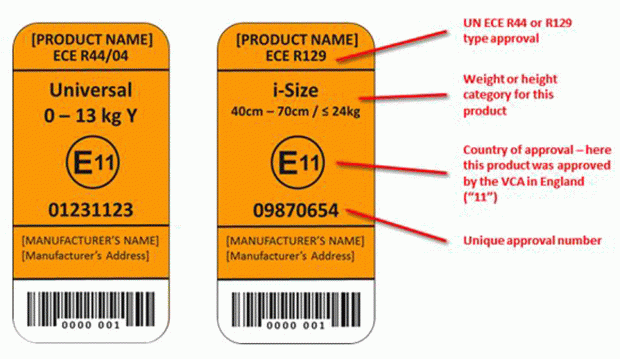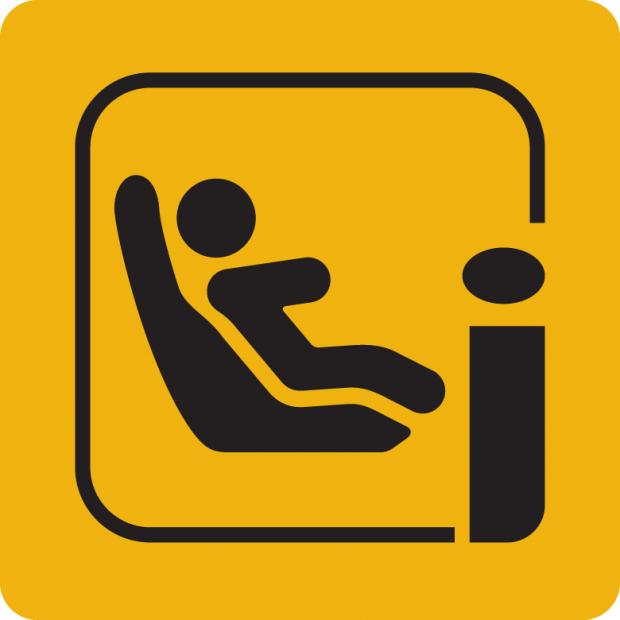Can I Put Car Seat in Car Without Seats
Child car seats, restraints and seat belts
Children are much more vulnerable than adults in a car so taking time to make sure you use the right child seat (restraint) or booster correctly, could save your child's life. Drivers and passengers are more likely to be killed or seriously injured when they don't wear a seat belt.
Child car seats, restraints and the law
You must use the right car seat for your child in:
- cars
- mini buses
- vans
- other goods vehicles
The driver must make sure that any child under 14 years old uses a seat belt or the right child restraint. Any child restraint used must conform to EU safety standards that is either Regulation 44.04 or Regulation 129 (also known as i-Size seats).
All children up to 135cm (approximately 4ft 5in) in height, or up to 12 years of age (whichever occurs first), must use a suitable child restraint – that is, one that is suitable for your child's height or weight.
There is a fixed penalty fine of £60 and three penalty points for not using the right child restraint. If the case goes to court, this could increase to a maximum fine of £500 for any occupant anywhere in the car.
Birth to three years of age
Children under three years of age must use a suitable child restraint. There is only one exception:
- a child under three may travel unrestrained in the rear of a taxi or a minibus if the right child restraint isn't available
Rear-facing baby seats must not be used in a seat protected by a front air-bag unless the air-bag has been deactivated.
From three to 12 years old
In vehicles where seat belts are fitted, children from three years to 12 years and up to 135cm in height (about 4ft 5in) must use the right child restraint.
Three exceptions allow these children to travel in the rear of the vehicle with the use of an adult seat belt:
- in a taxi if the right child restraint is not available
- for a short distance, in an unexpected necessity - if the right child restraint is not available
- where two occupied child restraints in the rear prevent the fitting of a third child seat and no suitable child restraint is available for use in the front passenger seat
There is also an exception for children with a a medical certificate saying that it is not advisable on medical grounds to wear a seat belt.
A child taller than 135cm must wear a seat belt where one is fitted.
Children 12 to 13 years or over 135cm in height
Children aged 12 or 13 years or over 135cm (regardless of age) in height must wear a seat belt where one is fitted.
Summary of seat belt and child restraint requirements
Choose the right child car seat for your child
You should choose a child car seat or restraint based on your child's height or weight.
There are two European standards for child restraint systems. These are Regulation 44 and Regulation 129 (or i-Size). Seats manufactured to either standard will have a label showing a capital 'E' in a circle - as shown in the picture.

The label will show which standard the child car seat meets – Regulation 44 or Regulation 129 (i-Size). Regulation 44 child car seats are based on weight with an age recommendation. Regulation 129 (or i-Size) child car seats are based on height/ length and have a maximum weight. The label will tell you the weight or maximum height/ length the child car seat is designed for.

Regulation 129 will replace Regulation 44 seats. Until then, seats manufactured to either standard are safe and legal when used properly.
Check the label to make sure it's suitable for your child and only use it in keeping with the manufacturer's instructions.
When buying a child restraint, if possible, try it in your car before you buy. Not all seats will fit or be suitable for your car. If you plan to use your child car seat in more than one car it is important to check that it fits other cars as well. Speak to the shop sales adviser who will give you advice and may show you how to fit the restraint correctly.
ROSPA website has information and tips on choosing and using child car seats.
Types of child restraints
A child restraint is the collective term for rear facing baby seats, forward facing child seats, booster seats and booster cushions.
Manufacturers may use different names and some products may cover more than one weight or height so it is important to read the label.
Regulation 44 child car seats
Regulation 44 child car seats are based on weight with an age recommendation and are divided into five weight groups:
Regulation 129 child car seats
Regulation 129 child car seats are based on length / height, have a minimum weight and are also known as i-Size seats. Child car seats approved according to Regulation 129 will be phased in over time. In the first phase (which is already in place) manufacturers are producing child car seats suitable for children up to 105cms – around four to four and a half years of age:
- the first stage i-Size child car seat is designed for children from birth up to 15 months and must be rear-facing - this will accommodate a child with a length/height up to about 83cm
- as well as the size range (length/ height) a maximum weight - up to which the child car seat can be used - is shown - so it is also important that you know the weight of your child
- each child restraint manufacturer will specify the length/ height range and maximum child weight for their product
- it is possible to keep your child in a rear facing seat beyond 15 months to 105cm length/ height - forward facing child car seats can be used from 15 months but you should delay this as outlined below under 'Use the restraint correctly'
- it is important to check the label to make sure the child car seat is suitable for the length/ height of the child using it and that you observe the maximum weight allowed
Use the restraint correctly
Every year too many children are killed or seriously injured on the roads – often because they are not properly restrained when travelling in a car. So make sure you understand the law and give your child the best possible protection.
Many seat experts believe that it's better and safer to keep your child in the lowest group seat for as long as possible. This means staying in their current stage seat until the maximum weight or height limit is reached. Because children grow and develop at different rates it is important to keep a watch on your child's height and weight to make sure that they don't move up a stage too early or too late.
You must only use a child restraint if your car's seat belt has a diagonal strap, unless the child restraint is:
- specifically designed for use with a lap seat belt only
- fitted using ISOFIX anchor points
Checklist
- check the label to make sure the child car seat is suitable for your child's weight and height
- fit the child restraint properly - follow the manufacturer's instructions
- every trip - allow time to get the child comfortably strapped in
- where using an adult belt to secure the restraint - make sure it passes through all the right slots
- make sure that the child restraint is tight in the adult seat
- make certain that the adult seat belt buckle is not bent over or resting on the child restraint frame
- never fit a rear-facing restraint with an active airbag in front of it
- check the vehicle handbook and follow the advice about children and airbags - where fitted
- deactivate any front airbags before fitting a rear-facing (baby) restraint in a front seat
- never modify the restraint or adult seat belt to make it fit
- never fit a child restraint in side-facing seats
Booster seat rules - no change for existing seats
- rules are now in force for backless booster seats (booster cushions)
- the rules apply to both Regulation 44 and Regulation 129 i-Size backless booster seats
- this means that manufacturers are not allowed to introduce new models of backless booster seats (booster cushions) for children shorter than 125cm, or weighing less than 22kg
- this change to technical standards means that the range of products available on the market will be better suited for younger children
- however the rules do not affect existing models of booster seats and booster cushions - parents can continue to use existing models available -if the labelling indicates that they are suitable for their child
- the key message is to check the label of the backless booster seat (booster cushion) that you are using or looking to buy - if the label shows that it is suitable for the child that you are carrying - you will not be breaking the law
More useful links
- Child car seats
- Good Egg Car Safety
Can I Put Car Seat in Car Without Seats
Source: https://www.nidirect.gov.uk/articles/child-car-seats-restraints-and-seat-belts
0 Response to "Can I Put Car Seat in Car Without Seats"
Post a Comment